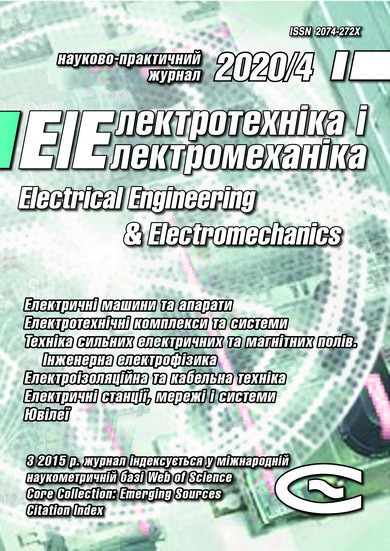MATHEMATICAL MODELLING OF TRANSIENTS IN THE ELECTRIC DRIVE OF THE SWITCH – THE MAIN EXECUTIVE ELEMENT OF RAILWAY AUTOMATION
DOI:
https://doi.org/10.20998/2074-272X.2020.4.03Keywords:
electric drive of the railroad switch, electromechanical switch systemAbstract
Goal. To develop a mathematical and imitation model of the electric drive of the railroad switch as a two- and three-mass electromechanical system based on DC and AC motors as the main executive element of railway automation. The modelling is based on the parameters of the SP-6m switches as the main modification of the executive element of the Ukrainian domestic railways automation system. Methodology. The authors have presented the mechanical part of the railroad switch as a three-mass construction scheme with serial connection of elastic masses. Special attention is paid to the character of the movement of the switch point tongues, when describing them in the form of two- and three- mass kinematic schemes, as well as to the mechanical state of the traction and connections as nodes, which are most sensitive to the negative effects of some modes of the railroad switch. Results. A simulation mathematical model of SP-6m switch for AC and DC motors, which allows to study the influence of various factors, has been developed and tested at the stand of the Automation Laboratory of the Ukrainian State University of Railway Transport, Kharkiv. The deviation in the basic parameters of the switch translation process is less than 5 %. Originality. For the first time a mathematical model of an electric drive of the railroad switch is developed, which takes into account elastic relations and load characteristics as an object of controlling the speed of movement of switch point tongues. Practical significance. We have created a mathematical model of the electric drive of the railroad switch which allows to examine the influence of various factors, including the influence of the environment on the operation of the switch.References
Kuznetsov B.I., Nikitina T.B., Kolomiets V.V., Bovdui I.V. Improving of electromechanical servo systems accuracy. Electrical engineering & electromechanics, 2018, no. 6, pp. 33-37. doi: 10.20998/2074-272X.2018.6.04.
Buriakovskyi S., Smirnov V., Asmolova L., ObruchI., Rafalskyi O., Maslii A. Analysis of optimization criteria for the process of switch displacement in a DC railroad turnout. Eastern-European Journal of Enterprise Technologies, 2019, vol. 6, no. 2 (102), pp. 58-69. doi: 10.15587/1729-4061.2019.187580.
Sokol Y.I., Buryakovskiy S.G., Masliy Ar.S. Energy-efficient electric drive of multifunctional turnout. Problemy Kolejnictwa, 2014, no. 165, pp. 99-107.
LagosR.F., San Emeterio A., Vinolas J., Alonso A., Aizpun M. The influence of track elasticity when travelling on a railway turnout. Proceedings of the Second International Conference on Railway Technology: Research, Development and Maintenance, 2014, p. 11. doi: 10.4203/ccp.104.208.
Papacek F. Turnout of new construction. International Railway Journal, 2000, no. 3, pp. 30-32.
Krishnan R. Switched reluctance motor drives. Modeling. simulation, analysis, design and applications. CRC Press, 2001. 432 p. doi: 10.1201/9781420041644.
Resnikov J.M. Strelochnye elektroprivody elektricheskoj i gorochnoj centralizacii [Switch electric drives of electric and mining centralization]. Moscow. Transport Publ., 1975. – p.152.
Latvian Railways Newsletter. Available at: http://ita.times.lv/Automatika/Otzimi1.html (assessed 19 February 2020).
Gluzberg B.E. Klassifikacija defektov i povrezhdenij elementov strelochnyh perevodov [Classification of defects and damage to the elements of the switchgears]. Moscow. Transport Publ., 1996. 87 p. (Rus).
Akimov L.V., Kolotilo V.I., Markov V.S. Dinamika dvuhmassovyh sistem s netradicionnymi reguljatorami skorosti i nabljudateljami sostojanija [Dynamics of two-mass systems with non-traditional speed controllers and state observers]. Kharkiv, KhSPU Publ., 2000. 93 p. (Rus).
Downloads
Published
How to Cite
Issue
Section
License
Copyright (c) 2020 S. G. Buriakovskyi, A. S. Maslii, O. V. Pasko, V. V. Smirnov

This work is licensed under a Creative Commons Attribution-NonCommercial 4.0 International License.
Authors who publish with this journal agree to the following terms:
1. Authors retain copyright and grant the journal right of first publication with the work simultaneously licensed under a Creative Commons Attribution License that allows others to share the work with an acknowledgement of the work's authorship and initial publication in this journal.
2. Authors are able to enter into separate, additional contractual arrangements for the non-exclusive distribution of the journal's published version of the work (e.g., post it to an institutional repository or publish it in a book), with an acknowledgement of its initial publication in this journal.
3. Authors are permitted and encouraged to post their work online (e.g., in institutional repositories or on their website) prior to and during the submission process, as it can lead to productive exchanges, as well as earlier and greater citation of published work.





